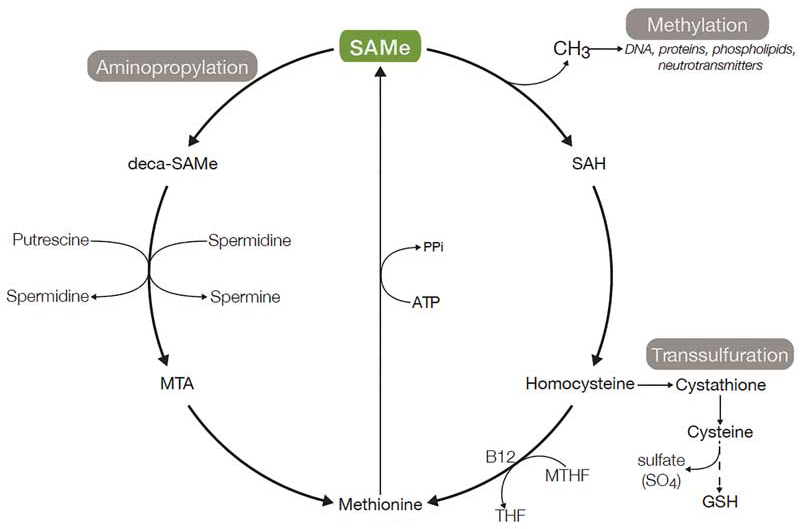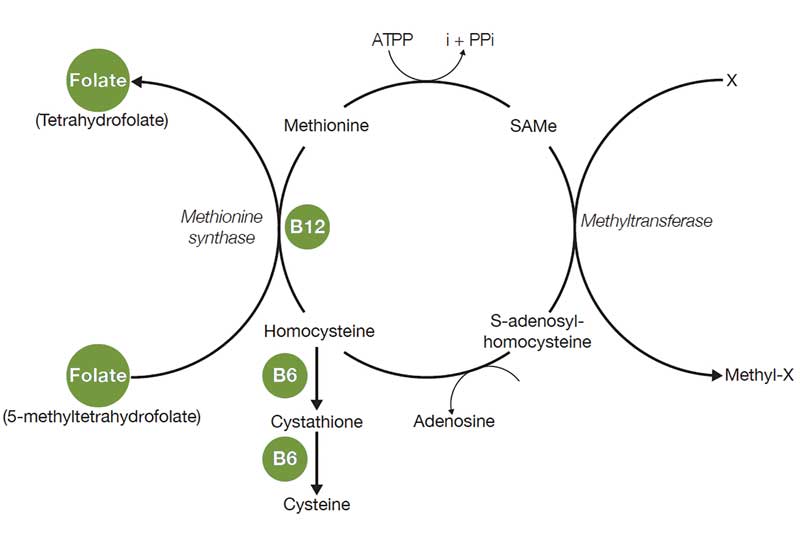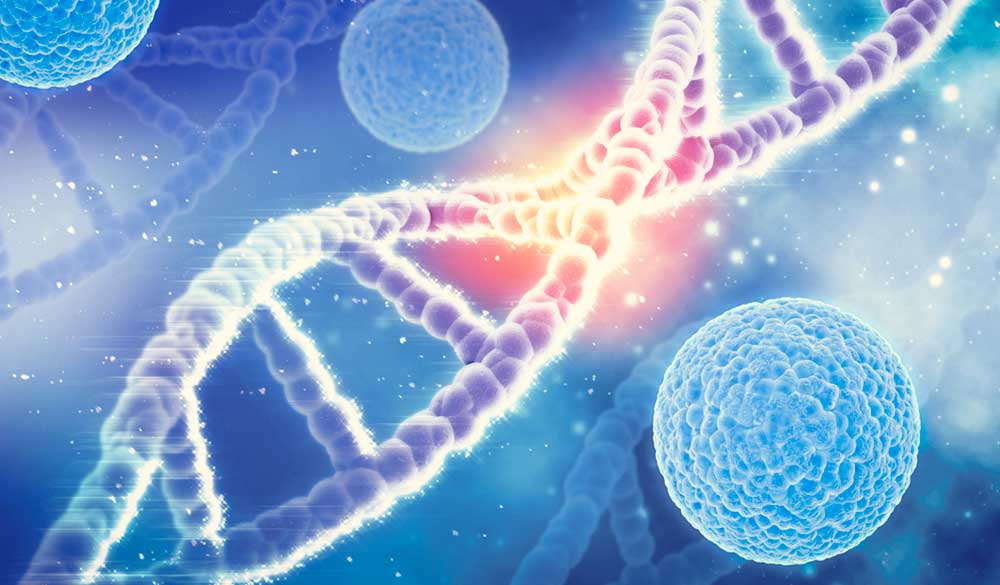Background
S-adenosylmethionine (SAMe), also known as ademetionine, is an endogenously produced compound first discovered in 1952.
SAMe exists biologically as a combination of two forms: (R)- SAMe and (S)- SAMe. Only the (S)- form is a listable component with the Therapeutic Goods Association (TGA) in Australia.
SAMe is produced from adenosine triphosphate (ATP) and methionine. It is found in every cell of the body and involved in more than 100 reactions. The highest concentrations are contained in the liver, adrenal glands and pineal gland. Both folate and vitamin B12 are required for the synthesis of SAMe in the body.[1-3]
SAMe is integral to cellular metabolism and as the major methyl donor in the body. SAMe is involved in the methylation of a diverse range of compounds including phospholipids, DNA, RNA, proteins and neurotransmitters. It is also involved in two other important pathways – transsulfuration which produces glutathione, and aminopropylation which synthesises polyamines.[2]
Key Benefits
- Increases neurotransmitter (dopamine, serotonin and noradrenaline) levels
- Helps maintain memory and brain function
- Influences fluidity of cell membranes
- Supports healthy liver function
- Involved in production of glutathione in the transsulfuration pathway
- Antioxidant
- Analgesic
- Anti-inflammatory
- Increases chondrocyte proteoglycan synthesis
- Induces synthesis of polyamines
Clinical Applications
- Depression and mood disorders
- Cognitive impairment
- Alzheimer’s disease
- Fibromyalgia symptoms – pain, fatigue, stiffness and mood
- Arthritis, joint inflammation
- Liver function
- Liver disease
- Migraines
Mechanisms of Action
SAMe is an essential precursor molecule involved in three main pathways crucial to cellular metabolism.
These pathways – methylation, transsulfuration and aminopropylation – require a steady source of SAMe.[2]

Figure 1. SAMe synthesised from methionine in the one-carbon metabolism cycle.[4]
This cycle is dependent on folate and vitamin B12 and involves the remethylation of homocysteine to methionine, which is in turn synthesised into SAMe.
Methylation plays an important role in maintaining cell membrane integrity. In phospholipid methylation, phosphatidylethanolamine is converted to phosphatidylcholine, with SAMe as the methyl donor, influencing the fluidity of the membrane (i.e. the greater the amount of phosphatidylcholine, the less viscous the cell membrane).[2]
SAMe-dependent methylation reactions are also required to synthesise the neurotransmitter monoamines serotonin, dopamine, adrenaline, noradrenaline and histamine.[2]
The transsulfuration pathway produces glutathione, a major cellular antioxidant. The partitioning of homocysteine between the transsulfuration and methylation pathways is regulated by the tissue concentrations of substrates and metabolites. When methionine is needed, homocysteine is remethylated by methyltetrahydrofolate (MTHF), but when methionine is in excess, catabolism of homocysteine via cystathionine beta-synthetase is accelerated.
Aminopropylation synthesises polyamines. This pathway conserves methionine and ensures rapid removal of methylthioadenosine, which is a potent inhibitor of S-adenosylhomocysteine hydrolase.[2]
The polyamines spermidine and spermine are involved in the control of cell growth and have analgesic and anti-inflammatory properties.[2]

Figure 2. Homocysteine metabolism pathway and the synthesis of SAMe[5]
Depression
SAMe has been prescribed as an antidepressant since the 1970s, and since then numerous clinical trials have confirmed its efficacy in treating depressive disorders.[2,3,6-8] The exact mechanism behind SAMe’s antidepressant effect is yet to be confirmed, but current research suggests that it may be due to a stimulatory effect on monoamine neurotransmitter metabolism, monoamine turnover, or both.[2]
Low serum and cerebrospinal fluid (CSF) levels of SAMe are a common finding in depressed patients. Supplementation with SAMe in human and animal studies have resulted in increased serum and CSF SAMe levels, increased brain concentrations of serotonin and noradrenaline and increased 5-hydroxyindole acetic acid (a marker for serotonergic activity).[2]
Deficiencies of both folate and vitamin B12 are also linked to depression and poor cognitive function, possibly due to reduced SAMe synthesis. Individuals with folate and B12 deficiencies are also less likely to respond to antidepressants. Like SAMe, folate and vitamin B12 are required by the brain for the synthesis of norepinephrine, serotonin and dopamine.[2,9]
Antioxidant activity and liver health
The liver is the major site of SAMe synthesis and degradation, and is vital for maintaining SAMe homeostasis. SAMe regulates hepatocyte growth, differentiation and death, and is involved in the synthesis of glutathione via the transsulfuration pathway.[10]
Up to 80% of methionine in the liver is converted to SAMe, where it is essential for glutathione production for antioxidant activity and reducing free radical toxicity generated by toxins including alcohol.[2]
Altered SAMe metabolism and reduced hepatic SAMe levels have been found in patients with liver disease.[2,10] Supplementation with SAMe has shown to increase glutathione levels in patients with liver disease, restore normal hepatic function, and protect against alcohol and CYP2E1 induced cytotoxicity.[2,10,11]
Osteoarthritis
Early clinical trials utilising SAMe for depression noted that patients receiving SAMe experienced marked relief from their osteoarthritic symptoms, and since, trials involving more than 22,000 participants have confirmed the therapeutic activity of SAMe against osteoarthritis.[2,12]
Experimental studies suggest that SAMe may reduce the symptoms of osteoarthritis by reducing inflammation and increasing chondrocyte proteoglycan synthesis.[2,13] SAMe may also reduce osteoarthritic pain by acting as an analgesic agent and may protect proteoglycans from damage caused by proteolytic and glycotic enzymes.[2]
While SAMe appears to have a slower onset of action, it has shown to be as effective as prescription anti-inflammatory medications with the beneficial effects continuing with time and even after supplementation is discontinued; an effect not seen with prescription anti-inflammatories.[13]
Clinical studies
Major depressive disorder
Background: To determine the efficacy of SAMe as an adjunctive treatment for antidepressant non-responders.
Subjects/Method: 6-week double-blind, placebo-controlled, randomised trial of 73 serotonin reuptake inhibitor (SRI) non-responders with major depressive disorder.
Intervention: 400mg SAMe twice daily (800mg) for 2 weeks, then increased to 800mg twice daily (1600mg) for an additional 4 weeks. Patients continued to take their prescribed antidepressant during the course of the trial.
Results: Individuals receiving SAMe had a statistically significant greater response rate than those receiving placebo (46.1% vs 17.6%). Remission rates in the SAMe group were also higher compared with placebo (35.8% vs 11.7%). SAMe is an effective, well tolerated and safe adjunctive treatment strategy for SRI non-responders with major depressive disorder.
Osteoarthritis
Background: To evaluate the efficacy and tolerability of SAMe versus an NSAID (nabumetone) in the treatment of knee osteoarthritis.
Subjects/Method: Double-blind, double-dummy, randomised, multicentre trial of 134 patients with knee osteoarthritis.
Intervention: After a washout period of 2 weeks, patients received either SAMe 400mg three time a day (1200mg/day) or nabumetone 1000mg once per day for a total of 8 weeks.
Results: Both SAMe and nabumetone effectively reduced pain intensity, with a significant improvement from baseline. The degree of pain reduction between the two groups was similar, as was the use of rescue medication and adverse events. The patient’s global assessment of disease status, physician’s global assessment of response to therapy, and WOMAC index scores were also similar between the two groups. Eight weeks of treatment with SAMe or nabumetone resulted in a similar reduction in pain intensity for patients with knee osteoarthritis.
Fibromyalgia
Background: To investigate the effects of SAMe supplementation on the symptoms of primary fibromyalgia.
Subjects/Method: Double-blind, placebo-controlled trial of 44 patients with primary fibromyalgia.
Intervention: 800mg SAMe daily or placebo for 6 weeks.
Results: SAMe supplementation resulted in improvements in clinical disease activity, pain, fatigue, morning stiffness and mood, compared with placebo. SAMe may improve the symptoms and disease activity of primary fibromyalgia.
Dosage Range For Conditions According To Clinical Studies
Absorption of SAMe is better via the duodenum than orally. Therefore it is best that SAMe is enteric-coated in order to reach the small intestine.[2]
|
Condition |
Daily dose | Results |
| Depression | 800-1600mg | Effective adjunctive treatment strategy for SRI non-responders with major depressive disorder.[3,14] |
| Osteoarthritis | 400-1200mg | Reduced pain intensity and clinical symptoms (morning stiffness, pain at rest, and pain on movement).[13,15,16] |
| Fibromyalgia | 800mg | Improvements in clinical disease activity, pain, fatigue, morning stiffness and mood.[17] |
| Liver disease | 400-1200mg | Reduced markers of lipid peroxidation, histological evidence of liver injury and improved mitochondrial glutathione.[19] |
| Migraine | 400-800mg | Reduced pain due to analgesic activity.[19] |
Cautions and Contraindications
- Avoid in bipolar disease.[3,18]
- Caution with use in schizophrenia and Parkinson’s disease.[19]
- Caution with coadministration of antidepressants. Although clinical studies combining these two medications indicate a favourable response among participants, with no incidence of serotonin syndrome.[3,19]
- SAMe methylates levodopa, which could theoretically reduce the effectiveness of levodopa given for Parkinson’s disease. However this has not been observed clinically. Observe.[19]
- Caution with use alongside thyroxine.[19]
- SAMe has been used intravenously in the last trimester of pregnancy with no adverse effects to mother or foetus. However, safety has not yet been conclusively established for either injectable or oral dose forms and possible effects on prolactin levels need to be considered.[19]
References
- S-adenosylmethionine. University of Maryland Medical Center, 2011. Viewed 17 March 2013 http://umm.edu/health/medical/altmed/supplement/sadenosylmethionine
- Bottiglieri T. S-Adenosyl-L-methionine (SAMe): from the bench to the bedside--molecular basis of a pleiotrophic molecule. Am J Clin Nutr 2002;76(5):1151S-1157S. [Full text]
- Papakostas GI, Mischoulon D, Shyu I, et al. S-adenosyl methionine (SAMe) augmentation of serotonin reuptake inhibitors for antidepressant nonresponders with major depressive disorder: a double-blind, randomized clinical trial. Am J Psychiatry 2010;167(8):942-948. [Full text]
- Vitamin B12. Micronutrient information center. Linus Pauling Institute Micronutrient Information Centre, 2003. Viewed 3 April 2017 http://lpi.oregonstate.edu/infocenter/vitamins/vitaminB12/
- Vitamin B12 and homocysteine metabolism. Micronutrient information center. Linus Pauling Institute Micronutrient Information Centre, 2003. Viewed 3 April 2017 http://lpi.oregonstate.edu/infocenter/vitamins/vitaminB12/figure9_1.html
- Papakostas GI. Evidence for S-adenosyl-L-methionine (SAM-e) for the treatment of major depressive disorder. J Clin Psychiatry 2009;70 Suppl 5:18-22. [Abstract]
- Williams AL, Girard C, Jui D, et al. S-adenosylmethionine (SAMe) as treatment for depression: a systematic review. Clin Invest Med 2005;28(3):132-139. [Abstract]
- Delle Chiaie R, Pancheri P, Scapicchio P. Efficacy and tolerability of oral and intramuscular S-adenosyl-L-methionine 1,4-butanedisulfonate (SAMe) in the treatment of major depression: comparison with imipramine in 2 multicenter studies. Am J Clin Nutr 2002;76(5):1172S-1176S. [Full text]
- Fava M, Mischoulon D. Folate in depression: efficacy, safety, differences in formulations, and clinical issues. J Clin Psychiatry 2009;70 Suppl 5:12-17. [Full text]
- Cederbaum AI. Hepatoprotective effects of S-adenosyl-L-methionine against alcohol- and cytochrome P450 2E1-induced liver injury. World J Gastroenterol 2010;16(11):1366-1376. [Full text]
- Friedel HA, Goa KL, Benfield P. S-adenosyl-L-methionine. A review of its pharmacological properties and therapeutic potential in liver dysfunction and affective disorders in relation to its physiological role in cell metabolism. Drugs 1989;38(3):389-416. [Abstract]
- di Padova C. S-adenosylmethionine in the treatment of osteoarthritis. Review of the clinical studies. Am J Med 1987;83(5A):60-65. [Abstract]
- Najm WI, Reinsch S, Hoehler F, et al. S-adenosyl methionine (SAMe) versus celecoxib for the treatment of osteoarthritis symptoms: a double-blind cross-over trial. BMC Musculoskelet Disord 2004;5:6. [Full text]
- Alpert JE, Papakostas G, Mischoulon D, et al. S-adenosyl-L-methionine (SAMe) as an adjunct for resistant major depressive disorder: an open trial following partial or nonresponse to selective serotonin reuptake inhibitors or venlafaxine. J Clin Psychopharmacol 2004;24(6):661-664. [Abstract]
- Kim J, Lee EY, Koh EM, et al. Comparative clinical trial of S-adenosylmethionine versus nabumetone for the treatment of knee osteoarthritis: an 8-week, multicenter, randomized, double-blind, double-dummy, Phase IV study in Korean patients. Clin Ther 2009;31(12):2860-2872. [Abstract]
- König B. A long-term (two years) clinical trial with S-adenosylmethionine for the treatment of osteoarthritis. Am J Med 1987;83(5A):89-94. [Abstract]
- Jacobsen S, Danneskiold-Samsøe B, Andersen RB. Oral S-adenosylmethionine in primary fibromyalgia. Double-blind clinical evaluation. Scand J Rheumatol 1991;20(4):294-302. [Abstract]
- Gören JL, Stoll AL, Damico KE, et al. Bioavailability and lack of toxicity of S-adenosyl-L-methionine (SAMe) in humans. Pharmacotherapy 2004;24(11):1501-1507. [Abstract]
- Braun L, Cohen M. Herbs & natural supplements, an evidence based guide, 3rd ed. Sydney: Churchill Livingstone Elsevier, 2010.
DISCLAIMER:
The information provided on FX Medicine is for educational and informational purposes only. The information provided on this site is not, nor is it intended to be, a substitute for professional advice or care. Please seek the advice of a qualified health care professional in the event something you have read here raises questions or concerns regarding your health.



